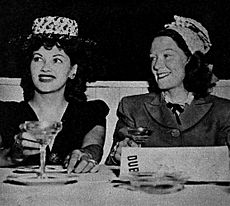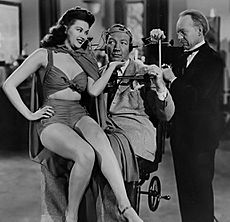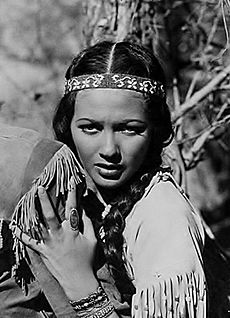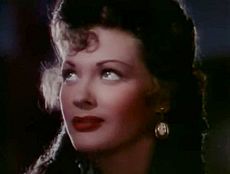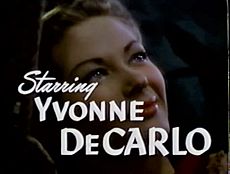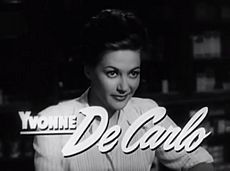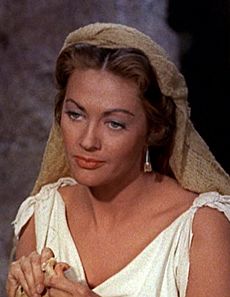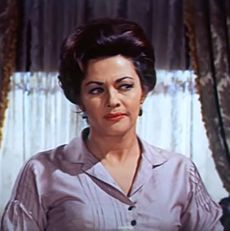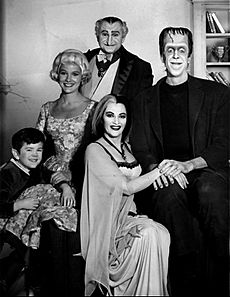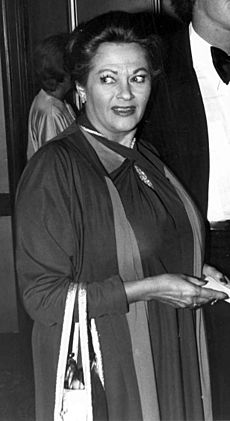Yvonne De Carlo facts for kids
Quick facts for kids
Yvonne De Carlo
|
|
|---|---|
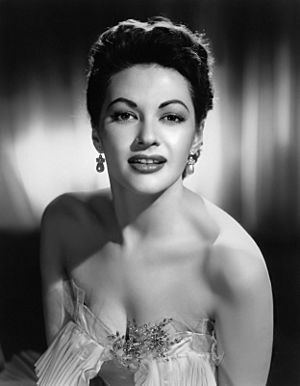
Yvonne De Carlo c. 1955
|
|
| Born |
Margaret Yvonne Middleton
September 1, 1922 Vancouver, British Columbia, Canada
|
| Died | January 8, 2007 (aged 84) Los Angeles, California, U.S.
|
| Occupation |
|
| Years active | 1939–1995 |
|
Notable work
|
Sephora in Cecil B. DeMille's The Ten Commandments (1956) |
| Television | The Munsters (1964–1966) |
| Political party | Republican |
| Spouse(s) |
Robert Drew Morgan
(m. 1955; div. 1973) |
| Children | 2 |
| Awards | 1957 Laurel Award for Topliner Supporting Actress for The Ten Commandments (1956) |
| Musical career | |
| Genres | |
| Instruments | Vocals |
| Labels | |
Margaret Yvonne Middleton (September 1, 1922 – January 8, 2007), known professionally as Yvonne De Carlo, was a Canadian-American actress, dancer and singer. She became a Hollywood film star in the 1940s and 1950s, made several recordings, and later acted on television and stage.
Born in Vancouver, British Columbia, De Carlo was enrolled by her mother in a local dance school when she was three. By the early 1940s, she and her mother had moved to Los Angeles, where De Carlo participated in beauty contests and worked as a dancer in nightclubs. She began working in motion pictures in 1941, in short subjects. She sang "The Lamp of Memory" in a three-minute Soundies musical and in 1942 signed a three-year contract with Paramount Pictures, where she was given uncredited bit parts in important films. Her first lead was for independent producer E. B. Derr in the James Fenimore Cooper adventure Deerslayer in 1943.
She obtained her breakthrough role in Salome, Where She Danced (1945), a Universal Pictures release produced by Walter Wanger, who described her as "the most beautiful girl in the world." The film's publicity and success turned her into a star, and she signed a five-year contract with Universal. Universal starred her in its lavish Technicolor productions, such as Frontier Gal (1945), Song of Scheherazade (1947), and Slave Girl (1947). Cameramen voted her "Queen of Technicolor" three years in a row. Tired of being typecast as exotic women, she made her first serious dramatic performances in two film noirs, Brute Force (1947) and Criss Cross (1949).
The first American film star to visit Israel, De Carlo received further recognition as an actress for her leading performances in the British comedies Hotel Sahara (1951), The Captain's Paradise (1953), and Happy Ever After (1954). Her career reached its peak when eminent producer-director Cecil B. DeMille cast her as Moses' Midianite wife, Sephora, her most prominent film role, in his biblical epic The Ten Commandments (1956), for which she won a Laurel Award for Topliner Supporting Actress. Her success continued with other notable starring roles in Flame of the Islands (1956), Death of a Scoundrel (1956), Band of Angels (1957), and The Sword and the Cross (1958), in which she portrayed Mary Magdalene.
She starred in the CBS sitcom The Munsters (1964–1966), playing Herman Munster's glamorous vampire wife, Lily, a role she reprised in the feature film Munster, Go Home! (1966) and the television film The Munsters' Revenge (1981). In 1971, she played Carlotta Campion and introduced the popular song "I'm Still Here" in the Broadway production of the Stephen Sondheim musical Follies. Yvonne, her best-selling autobiography, was published in 1987. A stroke survivor, De Carlo died of heart failure in 2007. She was awarded two stars on the Hollywood Walk of Fame for her contributions to motion pictures and television.
Contents
Early life
De Carlo was born Margaret Yvonne Middleton on September 1, 1922, at St. Paul's Hospital in Vancouver, British Columbia, Canada. Her nickname was "Peggy" because she was named after the silent film star Baby Peggy. Her mother, Marie De Carlo, was born in France to a Sicilian father and a Scottish mother. Marie, a "wayward and rebellious" teenager, had aspired to become a dancer and worked as a milliner's apprentice until she met Peggy's father, William Shelto Middleton, a salesman from New Zealand with "piercing eyes of pale blue, and a wealth of straight black hair." Marie and William married in Alberta, where they lived for a couple of months before returning to Vancouver. They moved in with Marie's parents, but the marriage was troubled. Peggy had only two memories of her father: climbing up to his knee and crawling toward his feet. By the time Peggy was three, William was involved in various swindles and fled Canada aboard a schooner, promising to send for his wife and child. Marie and Peggy never heard from him again; rumors said that he remarried twice and had more children, worked as an actor in silent films, or died aboard a ship. Peggy later wrote, "My own assumption is that he died before he had the chance to discover that his Baby Peggy had become a Hollywood actress, or I think he would have tried to contact me."
After William's departure, Marie left her parents' home and found work in a shop. Marie and Peggy lived in a succession of apartments in Vancouver, including one that had no furniture or stove, and periodically returned to the De Carlo home, "a huge white frame house", at 1728 Comox Street in Vancouver's West End neighborhood. Marie's parents, Michele "Papa" De Carlo and Margaret Purvis De Carlo, were religious, attended church regularly, and held services in their parlor. Michele, a native of the city of Messina, had met Margaret in Nice, France. They married in 1897, had four children, and settled in Canada.
De Carlo attended Lord Roberts Elementary School, located a block away from her grandparents' home.
De Carlo originally wanted to be a writer. She was seven when a school assignment, a poem she wrote titled "A Little Boy", was entered in a contest run by the Vancouver Sun. She won and received a prize of $5, which according to De Carlo, meant as much to her at that time as if she had won the Nobel Peace Prize. She also wrote short plays, which she usually staged in her grandparents' house, and even adapted Charles Dickens' A Christmas Carol for a neighborhood performance.
Marie wanted her daughter to have a career in show business and made sure Peggy received the necessary singing and dancing lessons. Peggy joined the choir of St. Paul's Anglican Church to strengthen her voice, and when she was ten (or three, according to a 1982 interview), her mother enrolled her in the June Roper School of the Dance in Vancouver. In May 1939, a Variety news item listed Yvonne de Carlo as one of the performers at the opening of Hy Singer's Palomar ballroom (also known as Palomar Supper Club) in Vancouver.
Early career
Beginnings in Hollywood (1940–1942)
De Carlo and her mother made several trips to Los Angeles. In 1940, she won second place in the Miss Venice beauty contest, and placed fifth in that year's Miss California competition (and can be seen in that pageant at 0:36 of the British Pathé film "A Matter of Figures"). At the Miss Venice contest, she was noticed by a booking agent who told her to audition for an opening in the chorus line at the Earl Carroll Theatre on Sunset Boulevard in Hollywood.
De Carlo and her mother arrived at Earl Carroll's for the audition, but after learning that Carroll would have to examine her "upper assets" before hiring her, De Carlo and her mother searched for work at another popular Hollywood nightclub, the Florentine Gardens. They met the proprietor, Nils Granlund, and he introduced De Carlo to the audience before she tap danced to "Tea for Two". Granlund then asked, "Well, folks ... is she in or out?" The audience responded with "a rousing round of applause, with whistles and cheers", and De Carlo got the job. She started in the back of the chorus line, but after months of practice and hard work, Granlund featured her in a "King Kong number." In it, she danced, and cast off several chiffon veils before being carried away by a gorilla. She was given more solo routines and also appeared in her first soundie.
She had been dancing at the Florentine Gardens only a few months when she was arrested by immigration officials and deported to Canada in late 1940. In January 1941, Granlund sent a telegram to immigration officials pledging his sponsorship of De Carlo in the U.S., and affirmed his offer of steady employment, both requirements to reenter the country.
In May 1941, she appeared in a revue, Hollywood Revels, at the Orpheum Theatre. A critic from the Los Angeles Times who reviewed it said the "dancing of Yvonne de Carlo is especially notable." She also made her debut on network radio with Edmund Lowe and Victor McLaglen, who were performing extracts from a series based on their Flagg-Quint performances.
De Carlo wanted to act. At the encouragement of her friend Artie Shaw, who offered to pay her wages for a month, she quit the Florentine Gardens and hired a talent agent, Jack Pomeroy. Pomeroy got De Carlo an uncredited role as a bathing beauty in a Columbia Pictures B film, Harvard, Here I Come (1941). She had one line in a scene with the film's star, boxer Maxie Rosenbloom. Her salary was $25 and her work in the film got her into the Screen Actors Guild. When no other acting jobs came her way, she decided to return to the chorus line and auditioned for Earl Carroll, who hired her. While working for Carroll, she won a one-line part in This Gun for Hire (1942) at Paramount. Carroll found out and fired her, as he did not allow his dancers to work outside the nightclub without his permission. She asked Granlund if he could rehire her and he did. In December 1941, she was dancing in the revue Glamour Over Hollywood at the Gardens. America's entry into World War II saw De Carlo and other Florentine dancers busy entertaining troops at USO shows. A skilled horsewoman, she also appeared in a number of West Coast rodeos.
Paramount Pictures (1942–1944)
Following an interview at Paramount, De Carlo was cast as one of Dorothy Lamour's handmaidens in Road to Morocco (1942). She was given a screen test for the role of Ata in The Moon and Sixpence, but lost the part to Elena Verdugo. She returned to Paramount for a bit role in Lucky Jordan (1942) and found another small part in a Republic Pictures film, Youth on Parade (1942), which she later called a "dreadful ... bomb". After recovering from a bout of bronchial pneumonia, she went to Paramount Pictures and signed a six-month contract, possibly going up to seven years, starting at $60 a week.
For her first assignment as a Paramount player, De Carlo was loaned out to Monogram Pictures to play a Florentine Gardens dancer in Rhythm Parade, starring Nils Granlund (who had requested her for the role) and Gale Storm. She then appeared as an extra in Paramount's The Crystal Ball (1943), of which she wrote, "Only my left shoulder survived after editing". She asked director Sam Wood for a part in his next film, For Whom the Bell Tolls (1943), and he gave her a small role in the cantina scene with Gary Cooper.
De Carlo was also seen in Let's Face It (1943), So Proudly We Hail! (1943) and Salute for Three (1943), She kept busy in small roles and helping other actors shoot tests. "I was the test queen at Paramount", she said later. But she was ambitious and wanted more. "I'm not going to be just one of the girls", she said. Cecil B. DeMille, Paramount's most famous director, saw De Carlo in So Proudly We Hail! and arranged for a screen-test and interview for a part in his film The Story of Dr. Wassell (1943), and subsequently selected her for a key role. He ended up choosing Carol Thurston for the role of Tremartini and casting De Carlo in an uncredited part as a native girl, but he promised her another role in a future film.
Shortly after losing the role of Tremartini, De Carlo was loaned out to Republic Pictures to portray the Native American princess Wah-Tah in Deerslayer. It was her first featured role in a full-length film. At Paramount, she played unbilled bit roles in True to Life (1943) and Standing Room Only (1944), and also made a screen test for the role of Lola in Double Indemnity (1944). She was billed in a short, Fun Time (1944) and went to MGM to play an uncredited lady-in-waiting in Kismet (1944).
The New York Times later dubbed De Carlo "threat girl" for Dorothy Lamour "when Dotty wanted to break away from saronging." This had its origin when De Carlo was set to replace Dorothy Lamour in the lead of Rainbow Island (1944); however Lamour changed her mind about playing the role. De Carlo was given a bit part in the final movie.
De Carlo played further unbilled roles in Here Come the Waves (1944), Practically Yours (1944), and Bring on the Girls (1945). Paramount then decided not to renew her contract option but did renew Lamour's contract.
Stardom
Salome, Where She Danced (1944–1945)
De Carlo was screen tested by Universal, who were looking for an exotic glamour girl in the mold of Maria Montez and Acquanetta. The test was seen by Walter Wanger who was making an adventure film in Technicolor, Salome, Where She Danced (1945). Wanger later claimed he discovered De Carlo when looking at footage for another actor in which De Carlo also happened to appear (Milburn Stone).
Wanger tested De Carlo several times and Universal signed her to a long-term contract at $150 a week. In September 1944, it was announced De Carlo was cast in the lead of Salome over a reported 20,000 other young women.
Though not a critical success, Salome was a box office favorite, and the heavily promoted De Carlo was hailed as an up-and-coming star.
Universal-International (1946–1950)
Universal signed de Carlo to a long-term contract. She was used by the studio as a backup star to Maria Montez, and her second movie for the studio saw her step into a role rejected by Montez: the Western Frontier Gal (1946) alongside Rod Cameron. In 1946, exhibitors voted De Carlo the ninth-most promising "star of tomorrow." Like Salome, it was shot in Technicolor.
De Carlo followed Frontier Gal with a top-billed role in Walter Reisch's Technicolor musical Song of Scheherazade (1947), co-starring Brian Donlevy and Jean-Pierre Aumont. Tilly Losch, an Austrian dancer and friend of Reisch, coached De Carlo in her three dancing solos. The film was a hit, making over $2 million.
De Carlo wanted to act in different types of movies. She applied to play the part of a waitress in A Double Life (1947) but lost out to Shelley Winters. Instead, Universal put her back in Technicolor for Slave Girl (1947), made with the producers of Frontier Gal. It was another solid commercial success. De Carlo was given a small role in Brute Force (1947), a prison movie starring Burt Lancaster and produced by Mark Hellinger. It was her first movie in black and white since becoming a star and her first to get good reviews.
She played Lola Montez in Black Bart (1948), a Technicolor Western with Dan Duryea for director George Sherman. Duryea and Sherman worked with her again on River Lady (1948). De Carlo called these films "physically taxing but not creatively inspiring."
She romanced Tony Martin in Casbah (1948), a musical remake of Algiers (1938) made for Martin's own production company but released through Universal. De Carlo was reluctant to be in it because, though she would receive top billing over Martin, she did not get the female lead. That part went to Swedish newcomer Märta Torén. However, studio head William Goetz insisted that De Carlo play Inez, the role Sigrid Gurie acted in the 1938 version. She also sang the film's song For Every Man There's a Woman, which was nominated for the Academy Award for Best Original Song. The film flopped at the box office, de Carlo's first flop since becoming a star.
De Carlo then received an offer from Mark Hellinger to make another film with Burt Lancaster: the film noir Criss Cross (1949). This time De Carlo had a larger role, as a femme fatale, Anna. Bosley Crowther noted that De Carlo was "trying something different as Anna. The change is welcome, even though Miss de Carlo's performance is uneven. In that respect, she is right in step with most everything else about Criss Cross." The film has become regarded as a classic and De Carlo considered the role the highlight of her career to date. Tony Curtis made his debut in the movie, in a scene dancing with De Carlo.
De Carlo was keen to make more movies along this line but Universal put her back in Technicolor Westerns with Calamity Jane and Sam Bass (1949), playing Calamity Jane, directed by Sherman, alongside Howard Duff.
She played a role intended for Deanna Durbin in The Gal Who Took the West (1950), for director Fred de Cordova. The movie gave her a chance to show off her singing voice. Trained in opera and a former child chorister at St Paul's Anglican Church, Vancouver, De Carlo possessed a large vocal range. She was meant to be in Bagdad (1949) but suffered a miscarriage and was ill, so the studio cast Maureen O'Hara.
De Cordova directed de Carlo in Buccaneer's Girl (1950), a pirate movie set in 1810s New Orleans opposite Philip Friend. The director later called De Carlo "a doll ... underrated as an actress. She was most professional, worked hard, was very good at her craft, possibly was not a first class star but came in on schedule. She knew her lines, she danced and sang rather well, and she wanted very much to be a bigger star than she ever became."
She toured US army bases singing, then was in The Desert Hawk (1950), an "Eastern" with Richard Greene. She made a Western with Sherman, Tomahawk (1951), opposite Van Heflin, which was popular.
De Carlo toured extensively to promote her films and entertained US troops in Europe. She also began singing on television.
She received an offer from England to make a comedy, Hotel Sahara (1951) with Peter Ustinov. While in England, she asked Universal to release her from her contract, though it still had three months to go, and the studio agreed.
Post-Universal (1951–1954)
While in England, De Carlo recorded two singles, "Say Goodbye" and "I Love a Man". In March 1951 she signed a new contract with Universal to make one film a year for three years.
De Carlo went to Paramount to make a Western, Silver City (1951), for producer Nat Holt, co-starring alongside Edmond O'Brien for a fee of $50,000.
In 1951, De Carlo accepted an offer to open the thirtieth season of the Hollywood Bowl singing the breeches role of Prince Orlovsky in five performances of the opera Die Fledermaus (The Bat), from July 10 to 14. The performances were conducted by noted film composer Franz Waxman. In her autobiography she described her participation in Die Fledermaus as "a rewarding experience, the aesthetic highlight of my life."
In August 1951, De Carlo became the first Canadian film star to visit the State of Israel, giving concerts in Haifa, Ramat Gan, Jerusalem, Tel Aviv, and Jaffa. She drew capacity audiences and was "royally received" by the Israeli government and the public. Her performances consisted of singing and dancing routines from her films. Furthermore, she found that her films were extremely popular there, saying, "Every time I played a concert, someone would yell, 'Sing something from Casbah.'" About the warm reception she received in Israel, she told columnist Louella Parsons:
De Carlo returned early from Tel Aviv to make The San Francisco Story (1952) with Joel McCrea. It was the first of a two-picture deal with Fidelity Pictures; the second was to be The Scarlet Flame about Brazil's battle for independence, which was never made.
She made her live TV debut in "Another Country" for Lights Out (1952). De Carlo wanted to make a film for Sydney Box called Queen of Sheba with Peter Ustinov as Solomon but it was never made.
She went back to Universal for the first movie under her new contract, Scarlet Angel (1952) with Rock Hudson.
At Paramount she did another film for Nat Holt, Hurricane Smith (1952), then she appeared in "Madame 44" for The Ford Television Theatre (1952). She announced plans to form her own production company with her agent, Vancouver Productions. However, as she later wrote "absolutely nothing" came of this.
De Carlo went to MGM to make Sombrero (1953), mostly shot in Mexico. She liked her character because it was "almost madonnalike.It is a role that demands the most sincerity for its proper interpretation. Many pictures that I have done perhaps offered me typical outdoor parts or western, heroine parts. So long as I could convey a flashy sort of impression it was alright... I don't deny the importance of such parts for me. They are excellent. But is stands to reason that as one goes on one seeks less superficial assignments.
De Carlo was reunited with Hudson for Sea Devils (1953), a Napoleonic adventure tale shot in Britain and France released through RKO. This meant she had to postpone a film she was going to make for Edward Small, Savage Frontier. She was offered a role in Innocents in Paris (1953) but ultimately did not appear in the film.
Back in the US, she had an adventure film set in the desert, Fort Algiers (1953), for United Artists, starring Carlos Thompson, whom de Carlo had recommended.
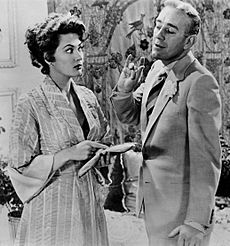
She made her third film in Britain with The Captain's Paradise (1953).
De Carlo made a fourth film in England, Happy Ever After (1954) with David Niven, then was called back to the US to do a contemporary comedy on TV, The Backbone of America (1953) with Wendell Corey.
De Carlo went back to Universal to make a Western with McCrea, Border River (1954), directed by Sherman. She went to Italy for The Contessa's Secret (1954) and returned to Hollywood for the independently produced Passion (1954). She wrote a 42-page treatment for a science-fiction film Operation Sram, which was not made. De Carlo made the Western Shotgun (1955) with Sterling Hayden for Allied Artists. She did "Hot Cargo" for Screen Director's Playhouse (1956) with Rory Calhoun directed by Tay Garnett.
De Carlo made her third film for Universal under her new contract in Raw Edge (1956). Republic starred her as Minna Wagner in a biopic of Richard Wagner, Magic Fire (1956). On TV she was in "The Sainted General" for Star Stage (1956). Republic reunited her with Duff in Flame of the Islands (1956), shot in the Bahamas.
The Ten Commandments and last notable film roles (1954–1963)
In September 1954, producer-director Cecil B. DeMille cast her as Sephora, the wife of Moses (played by Charlton Heston), in his biblical epic The Ten Commandments, a Paramount Pictures production that premiered in November 1956. In his autobiography, DeMille explained he decided to cast De Carlo as Moses' wife after his casting director, Bert McKay, called his attention to one scene she played in Sombrero. Even though the film "was a picture far removed in theme from The Ten Commandments", wrote DeMille, "I sensed in her a depth, an emotional power, a womanly strength which the part of Sephora needed and which she gave it."
She prepared extensively for the role, taking weaving lessons at the University of California, Los Angeles, and shepherding lessons in the San Fernando Valley. Months before filming began, she had worked on the part with a drama coach. Her scenes were shot on Paramount's sound stages in 1955. Her performance received praise from critics. Crowther, the New York Times critic, was impressed: "Yvonne De Carlo as the Midianite shepherdess to whom Moses is wed is notably good in a severe role." The Hollywood Reporter wrote that she "is very fine as the simple Sephora," and New York Daily News noticed that she "plays the wife of Moses with conviction." De Carlo was expected to receive an Academy Award nomination for Best Supporting Actress, but she preferred to be listed as a leading actress on the voting ballot and was not nominated in that category. However, she won a Laurel Award for Topliner Supporting Actress for her performance in the film.
She fell in love with stuntman Bob Morgan while visiting the filming of The Ten Commandments in Egypt in 1954. They married in 1955, and their first son, Bruce, was born in 1956. DeMille became Bruce's godfather. Her second pregnancy meant she had to turn down the role of the female pirate DeMille had given her in his next production, The Buccaneer (1958).
It was announced she would team with Vittorio De Sica in an adaptation of The Baker's Wife to be shot in English and Italian but the film was never made. Neither were two projects de Carlo was meant to make in Italy following Raw Edge, The Mistress of Lebanon Castle with Trevor Howard and Honeymoon in Italy.
Instead De Carlo co-starred with George Sanders and Zsa Zsa Gabor in Death of a Scoundrel (1956). The New York Times commended her performance as Bridget Kelly: "Yvonne De Carlo does a solid and professional job as the adoring petty thief who rises to eminence with him [Sanders' character]." On the small screen she was in "Skits & Sketches" for Shower of Stars (1957). She was also in Schlitz Playhouse (1957)
De Carlo released an LP record of standards called Yvonne De Carlo Sings on Masterseal Records, a subsidiary label of Remington Records, in 1957. Orchestrated by future film composer John Williams under the pseudonym "John Towner", the album contains ten tracks, "End of a Love Affair", "In the Blue of Evening", "I Got It Bad (and That Ain't Good)", "Am I Blue?", "Little Girl Blue", "Blue Moon", "But Not for Me", "My Blue Heaven", "Mood Indigo", "One for My Baby (and One More for the Road)".
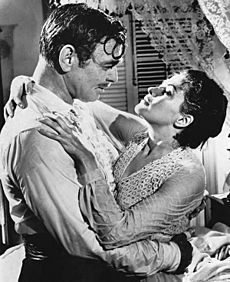
As a result of the great success and positive reviews of The Ten Commandments, De Carlo was offered lead roles in two Warner Bros. films that would be shot at the same time: The Helen Morgan Story and Band of Angels, based on Robert Penn Warren's novel. De Carlo chose the latter because her co-star would be Clark Gable, one of her favorite actors. The title refers to the short life expectancy of the black soldiers who fought with the Union troops in the Civil War, but the story is mainly about Amantha "Manty" Starr, a mixed-race Southern belle who is sold as a slave after her father's death and discovers that her deceased mother was a black slave on her father's plantation. Amantha is then taken to New Orleans where she is bought by plantation owner Hamish Bond (Gable), who falls in love with her. The film was both a critical and financial disappointment at the time of release.
De Carlo was in "Verdict of Three" for Playhouse 90 (1958). She made a French Foreign Legion movie with Victor Mature, Timbuktu, directed by Jacques Tourneur (1958). She unsuccessfully auditioned for the Broadway musical Destry Rides Again losing out to Dolores Gray.
In May 1958, De Carlo was signed to play Mary Magdalene in the Italian biblical epic The Sword and the Cross (tentatively titled The Great Sinner and released in the United States as Mary Magdalene), with Jorge Mistral as her love interest, the Roman Gaius Marcellus, and Rossana Podestà as her sister, Martha. The film's director, Carlo Ludovico Bragaglia, later remembered that "producer, Ottavio Poggi, had sent the provisional script to America, so Yvonne De Carlo could read it and decide on her participation in the film. She read it and got very excited, agreeing to play the role of Magdalene." The film was shot in English and later dubbed in Italian.
De Carlo put together a nightclub act and toured with it in South America. She guest-starred on Bonanza ("A Rose for Lotta", 1959), Adventures in Paradise ("Isle of Eden", 1960), Death Valley Days ("The Lady Was an M.D", 1961), Follow the Sun ("The Longest ... Game in History" [1961] and "Annie Beeler's Place", 1962) and Burke's Law ("Who Killed Beau Sparrow?", 1963). She also played Destry Rides Again in summer stock.
De Carlo's husband had become permanently disabled while working as a stunt man on How the West Was Won (1963), eventually losing his leg. De Carlo took any job going, appearing in night club acts across the country as well as a play in stock, Third Best Sport.
To help out, John Wayne offered her the supporting role of Louise Warren, the title character's cook in McLintock! (1963), with Wayne and Maureen O'Hara. She was second billed in a Western Law of the Lawless (1964) and played the Spanish dancer Dolores in the Bob Hope comedy A Global Affair (1964).
De Carlo was in "The Night the Monkey Died" for The Greatest Show on Earth (1964). She took over a role on Enter Laughing on Broadway for a week, and played in it when the production went on tour.
Later career
The Munsters (1964–1966)
She was in debt by 1964 when she signed a contract with Universal Studios to perform the female lead role in The Munsters opposite Fred Gwynne. She was also the producers' choice to play Lily Munster when Joan Marshall, who played the character (originally called "Phoebe"), was dropped from consideration for the role. When De Carlo was asked how a glamorous actress could succeed as a ghoulish matriarch of a haunted house, she replied simply, "I follow the directions I received on the first day of shooting: 'Play her just like Donna Reed.'" She sang and played the harp in at least one episode ("Far Out Munsters") of The Munsters.
After the show's cancellation, she reprised her role as Lily Munster in the Technicolor film Munster, Go Home! (1966), partially in hopes of renewing interest in the sitcom. Despite the attempt, The Munsters was cancelled after 70 episodes. Of the sitcom and its cast and crew, she said: "It was a happy show with audience appeal for both children and adults. It was a happy show behind the scenes, too; we all enjoy working with each other." Years later, in 1987, she said: "I think Yvonne De Carlo was more famous than Lily, but I gained the younger audience through The Munsters. And it was a steady job."
Stage work and Follies (1967–1973)
After The Munsters, she guest-starred in "The Moulin Ruse Affair" in The Girl from U.N.C.L.E. (1967) and "The Raiders" for Custer (1967) and episodes of The Virginian.
She starred in Hostile Guns (1967) and Arizona Bushwhackers (1968), a pair of low-budget westerns produced by A. C. Lyles and released by Paramount Pictures. During this time, she also had a supporting role in the 1968 thriller The Power.
After 1967, De Carlo became increasingly active in musicals, appearing in off-Broadway productions of Pal Joey and Catch Me If You Can. In early 1968 she joined Donald O'Connor in a 15-week run of Little Me staged between Lake Tahoe and Las Vegas and she did a five-month tour in Hello Dolly. Later she toured in Cactus Flower.
De Carlo continued to appear in films such as The Delta Factor (1970) and had a notable part in Russ Meyer's The Seven Minutes (1971). The Los Angeles Times said about the latter that De Carlo featured in "an improbable sequence pulled off with verve by the still glamorous star."
Her defining stage role was as "Carlotta Campion" in Harold Prince's production of the Stephen Sondheim musical Follies in 1971–72. Playing a washed-up star at a reunion of old theater colleagues, she introduced the song "I'm Still Here". De Carlo said she was told the part was written especially for her.
In October 1972, De Carlo arrived in Australia to replace Cyd Charisse in Michael Edgley's production of No, No, Nanette. Her opening night was on November 6, 1972, at Her Majesty's Theatre in Melbourne. The show moved on to Adelaide, Sydney, and then to several New Zealand cities. It closed in the fall of 1973, and De Carlo returned to the United States.
In late 1973 and early 1974, she starred in a production of Ben Bagley's Decline and Fall of the Entire World as Seen Through the Eyes of Cole Porter in San Diego.
In May 1975, she starred in the San Bernardino Civic Light Opera's production of Applause at the California Theatre of the Performing Arts. The San Bernardino Sun described her performance as "brilliant" and wrote, "a packed house watched Yvonne De Carlo give a new dimension to Margo Channing, a part she was playing for the first time, but nonetheless, a part she was very well suited for."
Later career (1974–1995)
De Carlo appeared in The Girl on the Late, Late Show (1974), The Mark of Zorro (1974), Arizona Slim (1974), The Intruder (1975), Blazing Stewardesses (1975), It Seemed Like a Good Idea at the Time (1975), Black Fire (1975), and La casa de las sombras (1976).
She continued to appear on stage, notably in Dames at Sea, Barefoot in the Park and The Sound of Music.
She was seen on Satan's Cheerleaders (1977), Nocturna (1979), Guyana: Cult of the Damned (1979), Fuego negro (1979), The Silent Scream (1979) and The Man with Bogart's Face (1980). She guest-starred on shows like Fantasy Island.
De Carlo was in The Munsters' Revenge (1981), then Liar's Moon (1982), Play Dead (1982), Vultures (1984), Flesh and Bullets (1985), and A Masterpiece of Murder (1986) (with Bob Hope). She was in a revival of The Munsters.
De Carlo's later films included American Gothic (1988), for which she won the Best Actress Award from International Science Fiction and Fantasy Film Show (Fantafestival); Cellar Dweller (1988); and Mirror Mirror (1990). She had a supporting role as the title character's Aunt Rosa in the Sylvester Stallone comedy Oscar (1991). Aunt Rosa is present when Oscar's father, played by Kirk Douglas, extracts "a deathbed promise" from his son. Of her role, De Carlo said, "Mine is a small part—but funny."
She appeared in Murder, She Wrote ("Jessica Behind Bars", 1985), The Naked Truth (1992), Seasons of the Heart (1993), and "Death of Some Salesmen" in Tales from the Crypt (1993). She had a small cameo role in Here Come the Munsters, a 1995 television film remake of The Munsters. De Carlo, along with Al Lewis, Pat Priest, and Butch Patrick, did not have to wear costumes "because the Munsters have several lives."
Her final performance was as Norma, "an eccentric Norma Desmond lookalike", in the 1995 television film The Barefoot Executive, a Disney Channel remake of the 1971 film of the same title. Norma, a former stand-in for film actors, "monkey-sits" the title character, a chimpanzee named Archie who is able to predict top-rated television series. "She has these outrageous costumes—six of them—and it's just a small part", De Carlo told Los Angeles Times. "But I like to do small things now."
In 2007, her son Bruce revealed that, before her death, she played supporting roles in two independent films that have yet to be released.
Personal life
In 1950, De Carlo purchased an eleven-room ranch house on five-and-a-half acres of "hilly woodland" on Coldwater Canyon Drive in Studio City, Los Angeles, above Beverly Hills. De Carlo described it as her "dream home" and hired an architect to help her design "an English-style dining room, with paneling and stained-glass windows." She also built stables for her horses and a large swimming pool. She sold the property in 1975. In 1981, she moved to a ranch in the Santa Ynez Valley, near Solvang, California.
Marriage
De Carlo met stuntman Robert Drew "Bob" Morgan on the set of Shotgun in 1955, but he was married and had a child, daughter Bari Lee, and De Carlo had "no intention of causing that marriage to break up." However, they met again, after the death of Morgan's wife, on the set of The Ten Commandments in Egypt, where they "seemed immediately attracted to each other." They were married on November 21, 1955, at St. Stephen's Episcopal Church in Reno, Nevada. De Carlo raised Bari as her own and had two sons with Morgan: Bruce Ross, whose godfather was Cecil B. DeMille; and Michael.
Bob Morgan was seriously injured and almost died while performing a stunt in the film How the West Was Won (1962). He was so badly hurt it took him five years to recover to the point where he was able to move by himself and walk unaided. Because his contract with MGM assumed no responsibility for the accident, De Carlo and Morgan filed a $1.4 million lawsuit against the studio, claiming her husband was permanently disabled.
After the accident, De Carlo worked arduously to support her family and was often away from home, touring with stage productions or performing in nightclubs. Morgan's constant arguing strained their marriage and De Carlo even considered divorcing her husband in 1968. When she returned home after a New Zealand tour of No, No, Nanette, she filed for divorce on the grounds of irreconcilable differences. They were divorced in July 1973.
Political views
De Carlo, a naturalized citizen of the United States, was an active Republican who campaigned for Richard Nixon, Ronald Reagan and Gerald Ford. In her autobiography, she recounted the time when she "loved to give interviews, and enjoyed being outspoken, or 'good copy,' openly discussing my survival instincts and admitting my to-the-right-of-right politics."
A conservative, she stated in a 1976 television interview with the CBC: "I'm all for men and I think they ought to stay up there and be the bosses, and have women wait on them hand and foot and put their slippers on and hand them the pipe and serve seven-course meals; as long as they open the door, support the woman, and do their duty in the bedroom, et cetera."
Religion
De Carlo's maternal grandparents came from distinct religious backgrounds: He was Catholic and she was Presbyterian. They raised her as an Anglican; she was a member and chorister of Vancouver's St. Paul's Anglican Church.
In her autobiography, De Carlo wrote about her faith in God: "God has saved me and mine from some pretty sticky situations. For me, religion is a little like being a Republican or a Democrat. It's not the party that counts, it's the man. Therefore, I care not what house of worship I enter, be it Catholic, Presbyterian, or Baptist. I elected God a long time ago and I'll stick with Him, because I don't think His term will ever be up."
Health and death
De Carlo suffered a minor stroke in 1998. She later became a resident of the Motion Picture & Television Country House and Hospital, in Woodland Hills, where she spent her last years. She died from heart failure on January 8, 2007, and was cremated.
Awards and honors
- In 1946, Variety named her one of the three "top new Hollywood stars" of 1945, along with Lizabeth Scott and Lauren Bacall: "Miss de Carlo is definitely a personality. She has proved this in Universal's Salome, Where She Danced, and followed this appearance as star in [the] same company's Frontier Gal. She is a controversial figure, but she's managed to come out a star during discussions."
- She was a medalist in Boxoffice Barometer's The All-American Screen Favorites of 1946 list.
- She was a medalist in Boxoffice Barometer's The All-American Screen Favorites of 1947 list.
- In 1947, Max Factor's chief hair stylist, Fred Fredericks, named her one of the 10 "best tressed" film actresses.
- In 1957, she won a Laurel Award for Topliner Supporting Actress for The Ten Commandments (1956).
- In 1957, she received a BoxOffice Blue Ribbon Award for The Ten Commandments (1956).
- In 1960, she was awarded two stars on the Hollywood Walk of Fame. The motion picture star is on the south side of the 6100 block of Hollywood Boulevard. The television star is on the north side of the 6700 block of Hollywood Boulevard.
- In 1964, she received a second BoxOffice Blue Ribbon Award for McLintock! (1963).
- In 1966, she was honored by the City of Niagara Falls, Canada, for "having created good will for her native country and given inspiration to others."
- In 1966, she was named honorary mayor of North Hollywood, Los Angeles.
- In 1987, she won the International Science Fiction and Fantasy Film Show (Fantafestival) Award for Best Actress for American Gothic.
- In 2005, she was one of the 250 female Hollywood legends nominated for the American Film Institute's 100 Years ... 100 Stars list.
- In 2007, she was nominated for the "Who Knew They Could Sing?" TV Land Award for The Munsters.
Filmography
Discography
Singles
- "I Love a Man" / "Say Goodbye" (Columbia, 1950)
- "Take It Or Leave It" / "Three Little Stars" (Capitol, 1955)
- "That's Love" / "The Secret of Love" (Imperial, 1957)
- "I Would Give My Heart" / "Rockin' In The Orbit" (Imperial, 1958)
Albums
- Yvonne De Carlo Sings (Masterseal, 1957)
Duets
- "You Belong to My Heart" with Bill Lee (included in That's Entertainment! The Ultimate Anthology of M-G-M Musicals)
- "Getting to Know You" with Frank Sinatra (included in The Frank Sinatra Duets)
See also
 In Spanish: Yvonne De Carlo para niños
In Spanish: Yvonne De Carlo para niños


